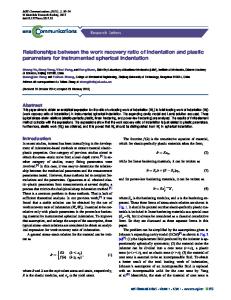Numerical verification for instrumented spherical indentation techniques in determining the plastic properties of materi
- PDF / 2,015,828 Bytes
- 11 Pages / 584.957 x 782.986 pts Page_size
- 95 Downloads / 347 Views
Numerical verification for instrumented spherical indentation techniques in determining the plastic properties of materials Taihua Zhanga) State Key Laboratory of Nonlinear Mechanics (LNM), Institute of Mechanics, Chinese Academy of Sciences, Beijing 100190, China
Peng Jiang State Key Laboratory of Nonlinear Mechanics (LNM), Institute of Mechanics, Chinese Academy of Sciences, Beijing 100190, China; and National Astronomical Observatories, Chinese Academy of Sciences, Beijing 100012, China
Yihui Feng and Rong Yang State Key Laboratory of Nonlinear Mechanics (LNM), Institute of Mechanics, Chinese Academy of Sciences, Beijing 100190, China (Received 16 June 2009; accepted 15 September 2009)
Instrumented indentation tests have been widely adopted for elastic modulus determination. Recently, a number of indentation-based methods for plastic properties characterization have been proposed, and rigorous verification is absolutely necessary for their wide application. In view of the advantages of spherical indentation compared with conical indentation in determining plastic properties, this study mainly concerns verification of spherical indentation methods. Five convenient and simple models were selected for this purpose, and numerical experiments for a wide range of materials are carried out to identify their accuracy and sensitivity characteristics. The verification results show that four of these five methods can give relatively accurate and stable results within a certain material domain, which is defined as their validity range and has been summarized for each method. I. INTRODUCTION
Over the past 10 years, a number of indentation-based methods have been proposed to measure plastic properties of materials.1–23 However, it is still contentious whether plastic properties can be accurately determined from an indentation test. For example, Cheng and Cheng2 have argued that the stress-strain curve may not be uniquely determined from loading and unloading curves by using the single sharp indenter method. In our opinion, rigorous verification is needed for these methods. Recently, extensive assessment of the multiple-indenter method has been reported by Lan and Venkatesh.3 However, from the user’s point of view, it is sometimes inconvenient to operate with distinct apex angle-indenters, which will add to the difficulty and cost of indentation tests. Recently, it has been shown that, with a spherical indenter, plastic properties can be determined from a single loading curve.18,19,23 By reviewing the spherical indentation methods that have been developed,7–23 the five models selected for this study were those of Field and Swain,14 Cao and Lu,18 Zhao et al.,19 Lee,11 and Jiang et al.23 Although there have certainly been many more studies performed on this a)
Address all correspondence to this author. e-mail: [email protected] DOI: 10.1557/JMR.2009.0428 J. Mater. Res., Vol. 24, No. 12, Dec 2009
topic, these five were selected for three reasons. First, they can be simply reproduced step by step according to only the
Data Loading...











